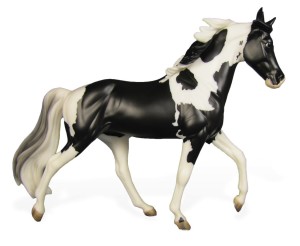Oh the walk… it can be the difference between winning and being out of the ribbons in a tough pleasure class. Unlike Dressage, where the quality of the walk is perhaps as important as the quality of the trot is to Saddle Seat riders, in Saddle Seat, as long as the horse is doing a 4 beat lateral gait, it’s a flat walk, no matter how “ugly” it might be.
 But getting a four beat, flat walk can be a difficult challenge on some horses. Most Saddle Seat horses are highly tuned to “go somewhere,” so walking is just not on their agenda. So how do you get your horse to flat walk, happily, for any length of time?
But getting a four beat, flat walk can be a difficult challenge on some horses. Most Saddle Seat horses are highly tuned to “go somewhere,” so walking is just not on their agenda. So how do you get your horse to flat walk, happily, for any length of time?
As soon as I figure that out, I’ll be a millionaire… but for now, I’ll share some of the things I do to make it more LIKELY that my horse will flat walk in the show ring (at least for a few steps).
Relax Yourself
Just like I suggested in my previous article about slowing down the canter, any tension in your body is going to transmit to the horse. You want to make sure your seat, legs, back and shoulders are relaxed. Envision a heavy sack of potatoes draped over the saddle. You want to be that sack.
Mix it Up
This seems to be a recurring theme in my training posts, but it’s for good reason. Routine can be a bad thing when it comes to training horses, because it often leads to anticipation and bad behaviors. Walking is no exception. Some things you can do to break up the routine and keep your horse paying attention to you and not making their own decisions:
- Frequent Halting. I like to halt, stand for a few seconds, walk a couple of steps, halt again, walk a few more steps… rinse and repeat. I do this frequently enough that the horse begins to anticipate halting so they don’t bother jigging, knowing they’ll be stopping again.
- Random Backing. I will sometimes ask a horse to back the second they start to jig. At first, when the horse has no idea what you’re doing, it can be a bit of a struggle to get them to go backwards when all they want to do is go forwards, faster. But, similarly to the frequent halting exercises, asking your horse to back from a forward gait puts “slow” into their head.
- Small Circles. If your horse starts jigging, try turning in a very tight circle. Whether this circle is towards the rail or away from it is up to you, but I like to keep it random. I’ll turn the horse usually towards the side of the bridle that he’s being resistant on (a lot of “failures to walk” come from resistance).
Off the Rail
My current horse walks like an old pony after a day plowing fields when I take him off the rail. On the rail? Jig jig jig. So I will often walk him off the rail and angle back towards the rail. I have to pay very close attention to his body language… I feel for that instant when he starts to tense up again, right before he starts to jig, and I’ll reverse course and send him back off the rail. If I do this enough, angling away from and back towards the rail, eventually the moment of tension becomes more and more delayed until eventually, he’s walking down the entire rail in a relaxed manner.
Extended and Collected Walk
One thing that Saddle Seat horses aren’t usually taught is that they can extend and collect their walk. But this is a very valuable tool to have in your arsenal! An extended walk is very lovely to see, and in the show ring, will really emphasize that your horse is WALKING. Whereas a collected walk can often appear mincing and tense, an extended walk will showcase relaxation. I like to start teaching my horse how to extend and collect his walk at the end of a workout, when he’s a bit tired. Since he relaxes off the rail, I do it up and down the center line, going from shorter reins and higher collection to longer reins and more extension. He’s getting pretty good at it in the cart and is slowly figuring it out under saddle. Who knows, maybe we’ll try the pleasure division next year!
Do you have any tips on teaching a show horse to relax and flat walk?
- Fixing the One-Sided Horse - March 28, 2016
- Running Martingales, Draw Reins and German Martingales – A Physics Lesson - November 23, 2015
- What to Do in the Off Season - October 14, 2015

Good info! I like your posts. In the past I was an AOT but at the moment have my 4yr old with a trainer..age and time! I hope to have him myself someday but this is good info for all riders, on there own or with trainers!
My horse is very relaxed at the walk when I totally throw him away, however when I collect him or maintain any contact with his mouth he starts jigging uncontrollably. Any pointers on working out of it while maintaining collection? He’s a half-Arabian english pleasure mount and though he knocks it out of the park with trot, the jigging kills us and ultimately places us on the bottom as the other horses are perfectly clean.
It sounds like he is anticipating moving off into the trot or canter when you gather him back up. I would first of all, never totally throw the reins away when coming to a walk. Maintain light contact. And then I would do a LOT of circling, serpentines, and direction changes at the walk, lots of practice with upward/downward transitions especially halt to walk to halt, and even asking him to back from a walk without halting first – anything to keep his mind busy and break him out of the thought pattern that “if she touches my mouth it’s time to GO!”
I will definitely try the suggestions, thank you! I only throw him away once he starts jigging to get him to relax, and once I do get him to stop jigging when being collected, he just stops and stands there and nothing in the world will get him going again. He has a way of challenging me as a rider!
By throwing him away when he starts to jig, you’re actually training him to only flat walk on a loose rein. That’s why I said to always maintain contact. Only practice correct things and don’t give in! He’s learning that if he jigs, you’ll let go of his mouth and he can slack off. He is perfectly capable of flat walking in collection – you just have to be consistent with asking him to do so. Good luck!
Thank you again!